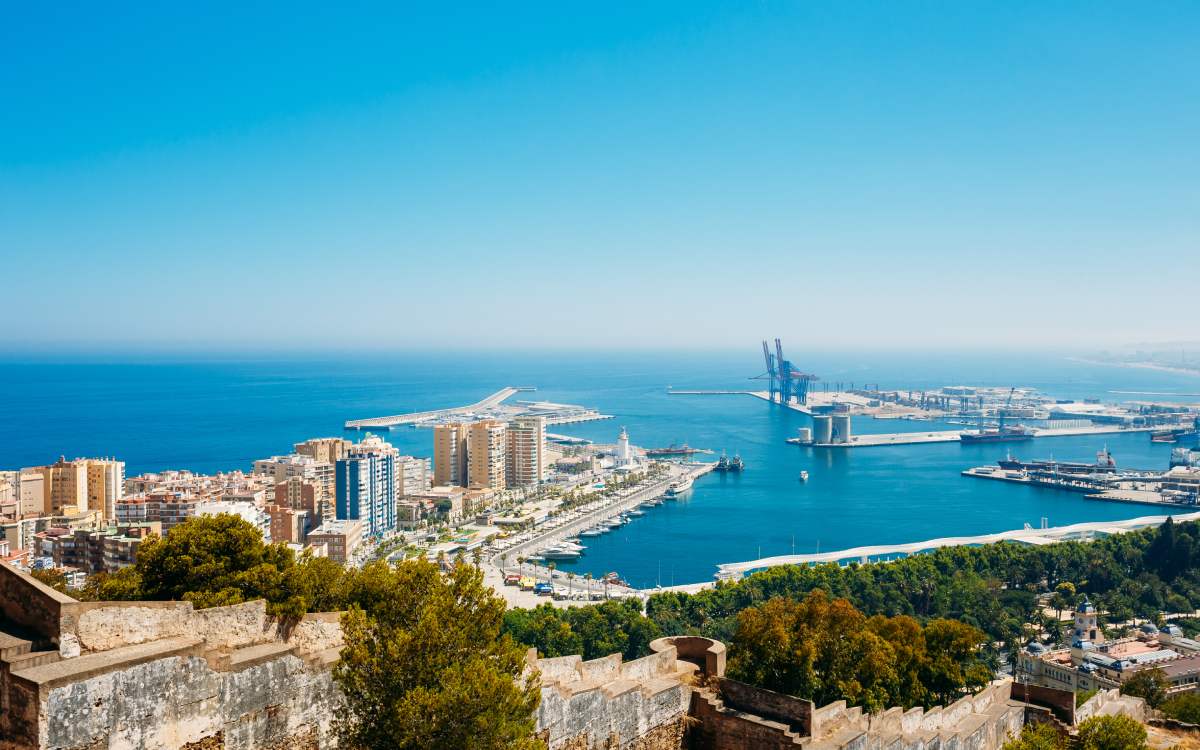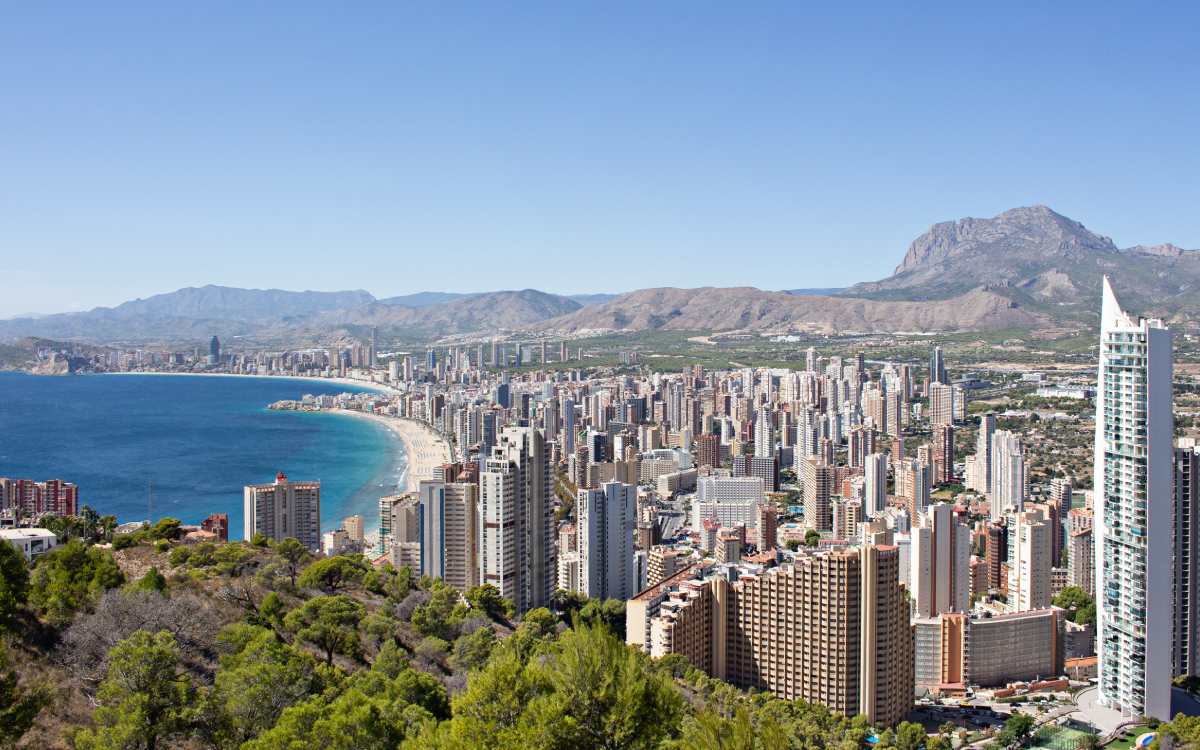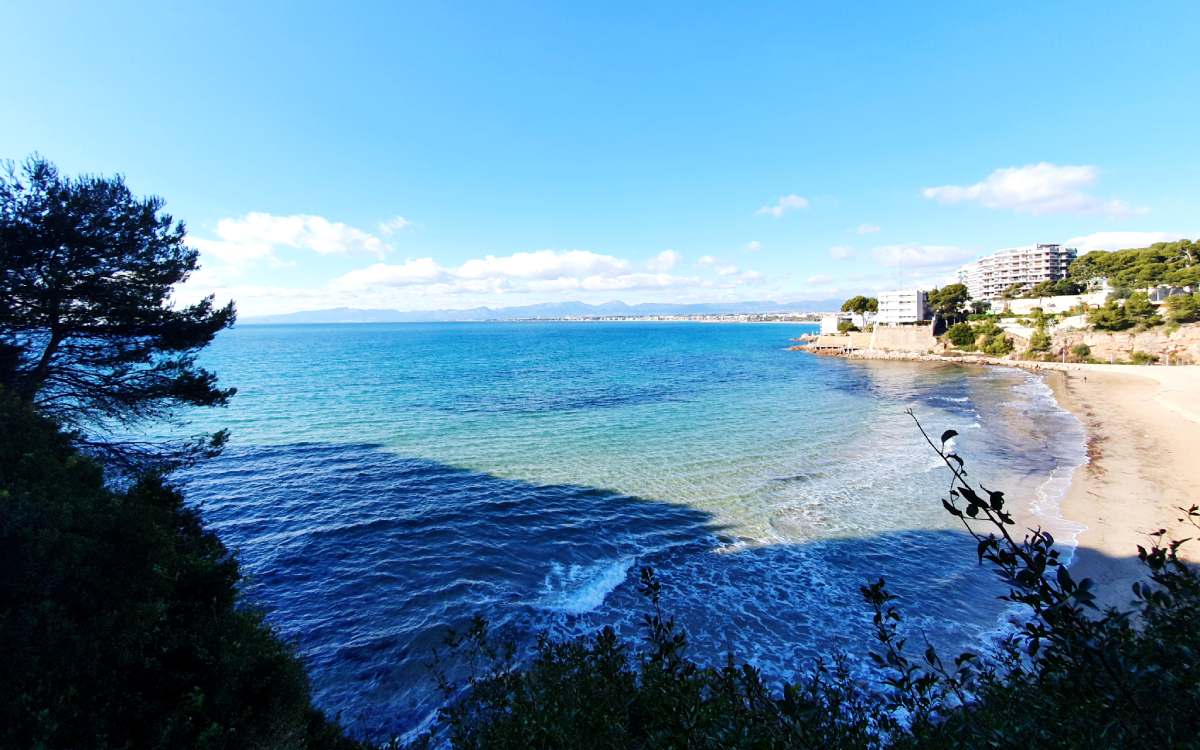
Weather is incredibly diverse in Spain, partly due to its rich geographical features and the influence of different climatic conditions. From the warm Mediterranean climate of Málaga and Valencia to the fresh and mild weather of Bilbao, each place has unique traits that make it perfect for a tailor-made journey. Discover the weather conditions of these popular destinations and plan your holidays with no surprises. Choose a place on the map of Spain and you will know if you need to pack an umbrella or sun cream!

Map of the weather in Spain. | Jhoy Rivera

Madrid. | Envato
The capital of Spain stands out for its dry climate with strong contrasts. It belongs to the continental Mediterranean climate which, as its name suggests, consists of a blend of the Mediterranean and continental climates. Temperatures fluctuate between 0°C and 33°C throughout the year, although it can easily reach 40°C on the hottest days of summer. Those who suffer with low temperatures should avoid visiting Madrid in January, the coldest month of the year with an average of 1°C minimum and 10°C maximum temperatures.
Madrid is not a particularly rainy city, but it useful to know when is it more likely to see raindrops on its windows. The season with less precipitation encompasses the months from June to October. The latter is the rainiest month, with an average of 45 millimetres of rain. The humidity levels are low and steady in Madrid, and it mostly stays at a 0% range. Regarding sunlight hours, it is estimated it has more than 2 600 per year.

Barcelona. | Envato
Barcelona boasts a nice Mediterranean climate, with mainly warm and humid summers. Temperatures tend to go from 5°C a 28°C throughout the year. Whereas the hottest month is August, the lowest temperatures will be reached in January, with an average of 8 °C.
The travellers seeking sunshine should visit it in July, where the skies are clearest. Likewise, for those who want to make sure that rain will not disrupt their plans, the driest season encompasses June, July and August. On the other hand, the month with most clouds and precipitation is October. Either way, the average of 61 millimetres of rain will not prevent us from enjoying such an interesting city with so many places to discover.

Bilbo/Bilbao. | Envato
From the warm Mediterranean coast, we will travel to the oceanic climate of Bilbao. It has humid and mild weather conditions that do not vary as much throughout the year. The temperatures fluctuate between 7 °C and 18 °C. The warmest month is August, with an average of 16 °C to 24 °C. Conversely, the coldest month would be January, with an average of 5 °C minimum and maximum of 12 °C.
It is worth noting that Bilbao has many cloudy days. The month with the clearest sky is July, whereas the driest season goes from May to September. In contrast, the rainiest month would be November, with an average of 91 millimetres of rain. It almost reaches the sum of all the rainiest months of Madrid and Barcelona.
Clouds seem to like this Basque city, and the number of sunshine hours that lit up its streets is never too high. It is calculated that Bilbao has approximately 1 600 hours of sunlight per year. Another element that frequently stops by here is the wind. It is worth knowing that the windiest season goes from October to April, the windiest month being December, with an average of 19.3 km/h. These weather conditions might seem a little hostile, but it is no impediment to visit all the museums, the architecture and the gastronomy of the capital of Bizkaia.

Seville. | Envato
We will leave behind this charming city crowned by clouds and Cantabrian breeze to visit the capital of a sunnier province. In fact, Seville welcomes the travellers with a Mediterranean climate of warm summers and smooth, mild winters. The temperatures vary from 6°C to 36°C, and the hottest month is July, with an average of 20-35°C. The sun and the inviting climate definitely contribute to the charms and popularity of this destination. A great place to visit when it comes to weather conditions in Spain.
Not many clouds sleep the siesta on Sevilla’s sky during the summer. It has not many precipitations either, December being the rainiest month, although it only has an average of 6 days of rain. The dry season extends from May to September. Lastly, Seville has about 2 900 hours of sunshine per year.

Málaga. | Envato
Less than 200 kilometres away, Málaga will welcome us with a similar climate. Hence, it boasts a Mediterranean weather with warm summers and mild winters. The temperature fluctuates between 7°C and 31°C throughout the year. The hottest month is August, with an average of 21-30°C.
The month that has more clear skies and less rainy days is July; the rainiest, December, has an average of 6 rainy days. The dry season goes from May to September, and Málaga has about 3 000 annual hours of sunshine. The bright, sunny climate of this Andalusian city makes it the perfect place to enjoy the best of the Costa del Sol.

Benidorm. | Envato
This popular tourist destination in the Valencian Community has a Mediterranean climate too, but its weather behaves in an unusual way. Indeed, Benidorm has a unique microclimate. Its weather conditions differ from the surrounding area for different reasons, like the position of its beaches and its natural barriers. In fact, the mountains encircling the city sometimes block the clouds and protect Benidorm from the rain they carry, an interesting case regarding the diverse weather in Spain.
The city has an average yearly temperature of 19ºC, and it fluctuates between 8°C and 29°C throughout the year. The warmest month is August, whereas the temperatures fall the most in January, with an average minimum of 8°C and maximum of 16°C. Thanks to the mountains that shelter it, Benidorm hardly ever sees rain. The rainiest month would be November, but it only has an average of 5 days of rain.
This city in Alicante features around 300 sunny days and 3 500 hours of sunshine every year. In addition, the water temperature has an average of 19.50°C throughout the year, just another reason to fall under the spell of this gem resting on the shores of the Mediterranean.

Valencia. | Envato
Valencia boasts a pleasant Mediterranean climate, smooth and mild throughout the year. The most enjoyable season is probably the one extending from May to October. From June to September, the average lowest and highest temperatures are 18º and 29º respectively, which makes it the perfect season to go for a swim in the Mediterranean waters. Besides, it hardly rains during this period of time.
Winters feel nice too in Valencia, with average temperatures fluctuating between 7º and 16º. October is the rainiest month, but it does not usually rain for more than 5 days. Valencia has 2 861 sunshine hours per year, which makes an average of 7.8 hours every day. Hence, any time of the year is great for getting to know this beautiful city.

Mallorca. | Envato
We will now head to the Balearic Islands, starting with Mallorca. Out of the three we will explore today, this is the one whose climate has more contrasts, mainly due to its mountainous landscape. However, its Mediterranean climate could be defined as mild. The best months to visit the island are June, July and August, where we will enjoy an average temperature of 18ºC and 29ºC. The sky is usually blue and clear, with no more than 10 daily millimetres of rain per month.
Temperatures remain mild in the months of winter, fluctuating between 5 ºC and 16ºC. Winds can reach a speed of 20km/h in December and January, and precipitations are considerably more abundant. Therefore, less people choose to visit Mallorca during this season. Something similar happens in spring and autumn, so the high season comprises the months of summer, which let us enjoy the island to the fullest.

Ibiza. | Envato
Similarly, the best months to visit Ibiza for those who want to make the most of its beaches and coves would be from June to August. During that time of the year, temperatures fluctuate between 21ºC and 28ºC. The sky is bright blue and clear during those three months too. At the end of the day, Ibiza is the perfect destinations for summer holidays, with enchanting beaches and a fresh sea breeze that always keeps the climate pleasant, even on the hottest days of summer.
Autumn is the rainiest season here, with an average of 55 millimetres of precipitation per day. During the months of winter, the wind can reach a speed of 21km/h, but it slows down when spring blooms.

Sunset in Menorca. | Envato
Menorca displays a similar Mediterranean climate, and it is perfect for visiting in summer. The sun shines an average of 1892 hours per year —that is, almost 8 hours every day. Considering that temperatures in summer fluctuate between a minimum of 21ºC and a maximum of 29ºC, we can be sure that the weather will not disrupt our visit to the island.
Regarding the rest of the seasons, Menorca stands out for being the windiest island, with an average of 26km/h during the winter months. It is also rainier than the others, and it has an average of 8 days of rain in October and November. However, it is still a great place to enjoy the weather of Spain.

Salou. | Envato
Yet another Mediterranean destination, but this time on the Catalan coast. Salou is one of the most popular places when it comes to summer holidays, and one of those destinations people choose when they want to enjoy the nice weather of Spain. This town in Tarragona boasts a warm climate that never really gets overwhelmingly hot, with an average of 19º-28ºC in summer. The Costa Dorada differs from the arid areas of the coast of Andalusia or the Costa Blanca due to its gentle climate. Precipitations are scarce, and the sky is mostly clear. This welcoming climate invites us to enjoy strolling around the town and its surroundings, as well as resting on the beach and swimming in the Mediterranean Sea.
The best season to visit Salou comprises the months between May and October, so one does not necessarily need to go in July or August, where the places will be more crowded. Either way, Salou is the perfect place for rest and leisure.

Empuriabrava. | Envato
Lastly, we will unlock the weather of one of the most charming corners of the Costa Brava. Indeed, its climate is perfect for enjoying beaches and nature. The Mediterranean influence over Empuriabrava offers soft and warm summers with average temperatures between 28ºC and 14ºC. Rain is scarce there too. There are usually about three rainy days per month, with occasional summer storms that are much appreciated.
If the traveller is seeking some beach holidays, the best season to visit Empuriabrava would be from September to October, where the water has an average temperature of 21ºC. However, one can bathe almost at any time of the year, considering that the sea has an average of 17ºC in May and November.